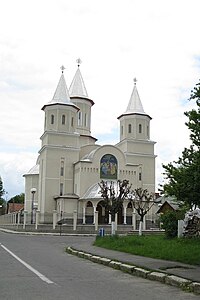Ștei
Ștei | |
|---|---|
 | |
 Location in Bihor County | |
| Coordinates: 46°32′24″N 22°28′12″E / 46.54000°N 22.47000°E | |
| Country | Romania |
| County | Bihor |
| Government | |
| • Mayor (2020–2024) | Iulian Balaj[1] (PNL) |
Area | 6.57 km2 (2.54 sq mi) |
| Elevation | 275 m (902 ft) |
| Population (2021-12-01)[2] | 5,398 |
| • Density | 820/km2 (2,100/sq mi) |
| Time zone | EET/EEST (UTC+2/+3) |
| Postal code | 415600 |
| Area code | (+40) 02 59 |
| Vehicle reg. | BH |
| Website | www |
Ștei (Template:Lang-hu) is a town in Bihor County, Crișana, Romania. Between 1958 and 1996, it was named Dr. Petru Groza, after the Romanian socialist leader who died in 1958.
The town is located in the southeastern part of the county, and lies on the banks of the river Crișul Negru.
History
| Year | Pop. | ±% |
|---|---|---|
| 1956 | 5,874 | — |
| 1966 | 5,754 | −2.0% |
| 1977 | 7,794 | +35.5% |
| 1992 | 10,415 | +33.6% |
| 2002 | 9,466 | −9.1% |
| 2011 | 6,144 | −35.1% |
| 2021 | 5,398 | −12.1% |
| Source: Census data | ||
The town was founded in 1952, near a village of the same name, as an industrial centre for the grinding of uranium mined at the nearby Băița mine, serving the intensive mining development set as an imperative by the Romanian Communist regime as part of a Soviet-Romanian joint venture during the Soviet occupation of Romania.
Romulus Vereș, the notorious Romanian serial killer, was institutionalised in the Ștei psychiatric facility in 1976, and died there in 1993.
Population
According to the 2021 census, Ștei has a population of 5,398. At the census from 2011, there were 6,144 people living within the city; of those, 96.6% were ethnic Romanians, while 2.88% were ethnic Hungarians, and 0.5% others.[3]
Natives
- Irina Bara, tennis player (born 1995)
- Camelia Adina Hora, singer (born 1986)
References
- ^ "Results of the 2020 local elections". Central Electoral Bureau. Retrieved 9 June 2021.
- ^ "Populaţia rezidentă după grupa de vârstă, pe județe și municipii, orașe, comune, la 1 decembrie 2021" (XLS). National Institute of Statistics.
- ^ Romanian 2002 Census




